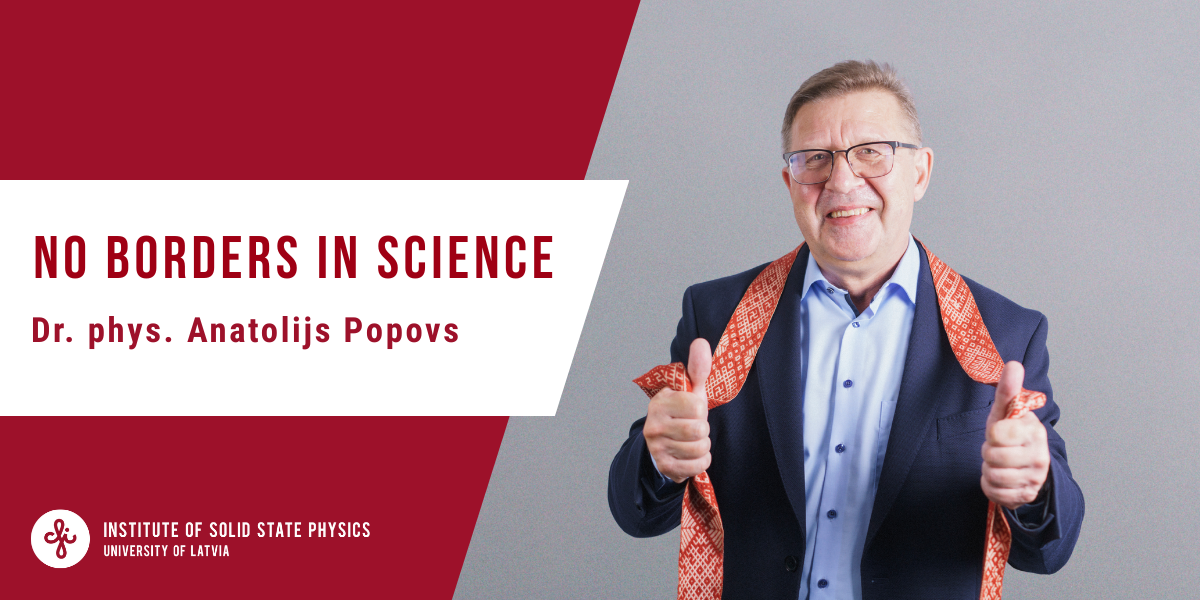
No Borders in Science is a series of interviews with Institute of Solid State Physics (ISSP UL) scientists and employees who are closely connected to the world outside of Latvia – by birth, attained education, or just their daily work. Through their stories we want to highlight the institute as a part of the global scientific network – a centre of excellence where collaboration isn’t limited by geography and the exchange of ideas, experiences, and efforts is placed at the forefront. This installment features Anatolijs Popovs who shares how the institute has grown into the collaborative and international environment it showcases today.
What are the specifics of your work and how does it include collaboration with foreign scientists?
For more than forty years, I have worked in various areas of solid-state physics, though during the past two decades my main research focus has been on radiation effects – studying how different materials and systems behave under radiation exposure. Over the years, I have led and initiated numerous projects at both the national level in Latvia and internationally, including the EUROfusion Enabling Research Projects. Many of these are large, collaborative efforts that unite research teams from several countries.
Collaboration with foreign scientists is truly at the core of my work. I have co-authored many joint papers with colleagues from Europe, the United States, Central Asia, and beyond. We frequently exchange data, discuss experimental results, and compare approaches to ensure that our findings are as accurate and comprehensive as possible.
Beyond research itself, I am also deeply involved in building and supporting the scientific community. I have organized and co-organized several international conferences, EMRS symposia, and international schools, all of which are a great chance not just to share ideas, but also to connect researchers across different disciplines and spark new projects.
In addition, I participate in several major international consortia and grant-funded projects, including those supported by different research programs such as Horizon Europe. These collaborations are an excellent way to combine resources, expertise, and technologies from multiple institutions, which allows us to make faster and more meaningful progress.
Overall, my work is inherently collaborative and international in nature. I strongly believe that science advances most effectively when it is pursued together – across borders, cultures, and perspectives.
What would you name as the strengths of ISSP UL?
In short, the foundation of our strength today is preserving the traditions and the high standards that have been developed and maintained over the past 50 years.
ISSP UL has several key strengths that make it a truly competitive and dynamic research center. First of all, the institute has a very strong tradition of fundamental and applied research in materials science and condensed matter physics. Over the years, it has developed deep expertise in areas such as functional materials, nanotechnology, photonics, and radiation effects – all supported by modern laboratories and advanced experimental facilities.
Another important strength is the highly qualified and internationally-connected research staff. Many of our scientists have long-term collaborations with leading universities and research centers across Europe, the United States, and Central Asia (e.g. Kazakhstan). This international environment encourages the exchange of ideas, mobility of researchers, and participation in large European consortia and projects like Horizon Europe and EUROfusion.
The institute is also very strong in combining basic research with practical applications. Many of our projects bridge the gap between science and industry, focusing on new materials and technologies that can be transferred to practical use. This makes our work relevant not only academically but also for innovation and technological development.
It’s important to reiterate that we’re not standing still – we’re always looking for new ideas and continuing to grow. In addition to our traditional research areas, we’re now focusing on microfluidics, biophotonics, and smart materials that already show real practical applications
Finally, I would highlight the supportive, creative atmosphere of the institute. There is a strong spirit of collaboration between different research groups and generations of scientists. Young researchers are actively involved in international projects and training programs, ensuring the continuity and growth of our scientific community. I can honestly say that young people today have wonderful support – something we couldn’t even dream of in the early ’90s.
In your experience, how does ISSP UL empower international cooperation?
ISSP UL really supports international cooperation in several ways. We take part in big projects and consortia like Horizon Europe and EUROfusion, which bring together teams from many countries. We also have long-term partnerships with universities and research centres worldwide, collaborate on papers, share data, and coordinate experiments.
On top of that, the institute organizes international conferences, workshops, and schools, giving researchers a chance to meet and start new collaborations. And researcher mobility is encouraged, so both young and senior scientists can gain international experience and bring fresh ideas back home – all they need is the desire to do it! Overall, ISSP UL makes international collaboration a natural part of everyday research.
How does ISSP UL assist scientists – foreign and home-grown (proliferating participation in projects and events, supporting funding acquisition, endorsing growth opportunities, etc.)?
We’re doing really well in this regard. ISSP UL supports both local and international scientists with lots of funding opportunities and helps us join projects and collaborations. It also offers workshops, schools, and conferences to develop skills, meet people, and share ideas. Overall, the Institute provides a supportive environment where researchers can grow, take on leadership roles, and thrive internationally.